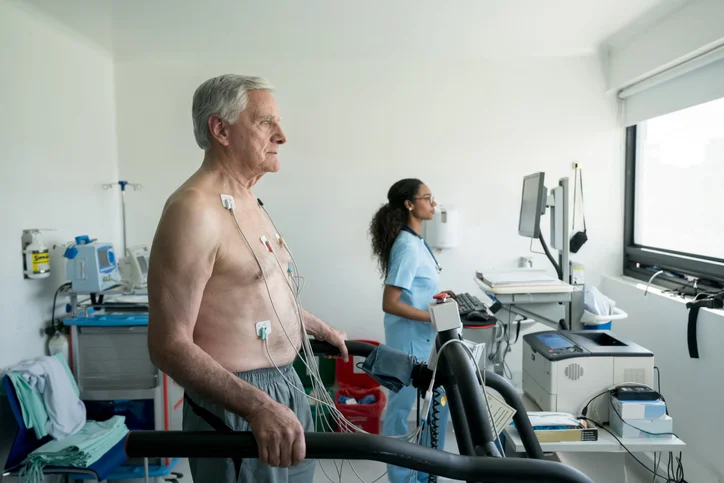What happens during an exercise stress test?
/What happens during an exercise stress test?
You’ve been experiencing chest discomfort during your evening walk or when climbing a flight of stairs. It disappears once you stop moving but it troubles you nonetheless. Anytime you are having unusual or out-of-the-ordinary aches and pains, it is strongly advised to discuss these symptoms with your doctor. When you do, one of the most common tests checking for a heart condition is the exercise stress test.
An exercise stress test, also called a treadmill test or more accurately, an exercise electrocardiogram (ECG), has been used for many years. As recently as a decade ago, doctors ordered these tests as part of a routine check-up in middle-aged adults, regardless of symptoms. Today they are mainly done in people with symptoms that suggest heart disease. Usually when someone is having predictable patterns of chest pain during exercise or over exertion, it often is diagnosed as angina. Angina occurs when the heart muscle isn’t getting enough blood, which is more likely during physical activity.
What does an exercise stress test measure?
The purpose of an exercise stress test is to use an electrocardiogram to record the heart’s electrical activity. The ECG reading can discover changes that can point to abnormalities in blood flow caused by blockages in the heart’s arteries or other problems in the heart. The test is also done before a person starts a cardiac rehabilitation program, and in some cases, before starting an exercise regimen.
I haven’t exercised for a while. Do I need a stress test before starting working out?
The answer to this question is it depends. Everyone is different and it will depend on your baseline risk for heart disease. Is there a strong family history of heart disease? How long have you been inactive? What type of physical activity are you planning on taking up?
As an example, if you are someone over the age of 60 who has a family history of heart disease and you want to become more physically active by taking a daily walk with your dog. You probably don’t need a stress test. But, if you have signed up for a 5K or longer marathon and you’ve been a couch potato for years, it would be advisable to discuss it with your doctor about getting an exercise stress test before you start training.
What happens during an exercise stress test?
Exercise stress tests are usually conducted by an exercise physiologist and supervised by a physician. The exercise physiologist will review your medical history, asking questions about your family health history and what heart-related symptoms you are having. They will also inquire about any joint problems with your knees, hips, or ankles.
Some exercise stress tests are done on a treadmill but some may use an exercise bike. Anyone who is unable to use their legs can use an arm-powered exercise machine.
Several small adhesive pads will be stuck on your chest and abdomen. Men may need to shave some chest hair in order for the pads to stick. Women can wear a sports bra with the chest pads placed just above and below the breasts. Each pad is attached to a plastic-coated wire that feeds into the ECG system. A cuff on your arms periodically measures your blood pressure.
Before beginning the test, a baseline recording will be taken while you’re at rest. Then you will begin either walking on a treadmill at a slow pace (under 2 mph). As you walk on the treadmill, the clinician is monitoring your heart’s electrical activity, your heart rate, and your blood pressure. Every few minutes, the speed and steepness of the treadmill increases, making you work harder. The goal is to exercise until you are too tired or out of breath. Some people may experience leg or chest pain causing them to stop. Of if the clinician discovers worrisome changes on the ECG or in blood pressure, they will stop the test.
Interpreting the results
The findings will either indicate everything is normal, abnormal or unclear. No exercise stress test is 100% accurate and about 10% to 15% of people with normal results may actually have significant coronary heart disease. The opposite is true in that up to 15% of people with an abnormal reading do not have heart disease.
If the results come back abnormal, this will warrant additional tests. An exercise ECG test that likely indicates further testing include:
· ECG changes signaling the heart isn’t getting enough blood, likely because of artery narrowing or blockages.
· If the heart is not beating as fast as it should with strenuous exercise or it is taking too long to slow down after exercise, you may have an electrical problem or another heart abnormality.
· If your systolic blood pressure (the top number) does not rise by at least 10 to 20 mm Hg or begins falling during exercise, you have heart muscle or valve abnormalities.
· If unusual heart rhythms are found, it may suggest coronary artery disease, cardiomyopathy, or an inherited heart problem.

